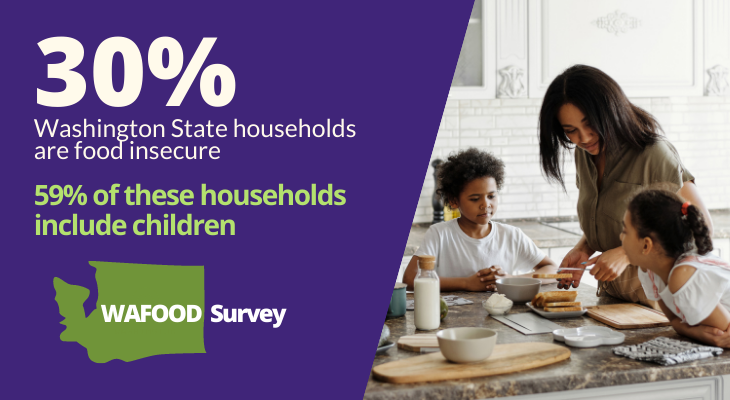Food insecurity in Washington State highest among low-income groups and persons of color
Food insecurity has spiked post Covid-19, affecting an estimated 30% of households in WA State and bringing many pre-existing social inequities to light. Highest rates were observed among households below the poverty line (58%), with some college education or less (44%), and for persons of color (42%).
Households with children were also affected. Of the food insecure households, 59% had children.
About 40% of all survey participants reported that their diet got worse. There were concerns about rising food costs, access, and transportation.
Post Covid-19 diets had more eggs, rice, beans, pasta and peanut butter but less meat, seafood, and milk and dairy. Store bought cakes and cookies decreased but there was a sharp increase in cooking at home.
“The shift to lower cost packaged foods may be temporary or it is here to stay” said Dr. Adam Drewnowski, survey director. “This is only the first wave”.
These are some of the early results from the Washington State Food Security Survey (WAFOOD) on economic security and food access in WA State during the COVID-19 pandemic.
The online WAFOOD Survey, funded by the University of Washington (UW) Population Health Initiative (UW PHI), was deployed from June 18th to July 31st, 2020. Its goal was to document the impact of the statewide shutdown due to the pandemic on employment conditions, income and food assistance, food security, and food shopping patterns.
The survey received 2,621 complete responses from 38 out of 39 counties in WA State. The online survey was available in English and in Spanish.
“Unemployment benefits, stimulus checks, and food assistance provided some relief” said Dr. Drewnowski. About 28% of households sought unemployment benefits and 77% of households received stimulus checks. In addition, 33% of households in the sample sought food assistance; however, participants reported barriers to accessing services, including that not all services were available online.
Receipt of Supplemental Nutrition Assistance Program (SNAP), School Meals, and Women, Infants and Children (WIC) declined slightly; meals from food banks, city agency grocery vouchers, and Summer School Meals went up.
“Not everyone was using the full range of food benefits that they were entitled to” said Dr. Jennifer Otten, survey co-director. “We need to keep monitoring food insecurity status and benefit use to help state agencies to be more nimble and responsive to families’ pressing needs. Food insecurity is likely to get worse as the pandemic progresses.”
The pandemic is also having effects on employment and long-term economic security prospects.
Sixty-seven percent of the WAFOOD respondents were employed prior to the shutdown.
About a quarter of the sample reported reduced work hours and about 18% of the sample reported temporary or permanent job closures and layoffs.
Of those employed, over half (54%) held jobs classified as essential and continued to report to work.
Those workers were found in community and social services, food and healthcare rather than in education, business, finance and office support.
The WAFOOD survey was a joint effort between the UW and WSU with collaboration from Tacoma Community College (TCC). Adam Drewnowski and Jennifer J. Otten are with the Center for Public Health Nutrition at UW. Laura R. Lewis is the Director of the Food Systems Program at WSU. Sarah M. Collier is with the Nutritional Sciences Program at UW. Brinda Sivaramakrishnan is with Tacoma Community College. Chelsea M. Rose, Alan Ismach, Esther Nguyen, and James Buszkiewicz are all with the Center for Public Health Nutrition at UW. WAFOOD survey was facilitated by numerous stakeholders and community partners from WA State agencies to NGOs, food banks, food pantries, charitable organizations community organizations, county health departments, and local health jurisdictions
For more information:
Dr. Adam Drewnowski is a professor of epidemiology at the University of Washington School of Public Health, and the director of the Center for Public Health Nutrition, the Nutritional Sciences Program, and the Collaborative for Obesity Research & Action (UWCOR). He holds a joint appointment in the Public Health Sciences Division with the Fred Hutchinson Cancer Research Center in Seattle.
Dr. Jennifer Otten is an associate professor of environmental and occupational health sciences at the University of Washington School of Public Health, a faculty researcher with the Center for Public Health Nutrition and the Collaborative for Obesity Research & Action (UWCOR). Dr. Otten is the co-director of the Livable City Year project, and food systems director and core faculty for the Nutritional Sciences Program.
September 24, 2020
